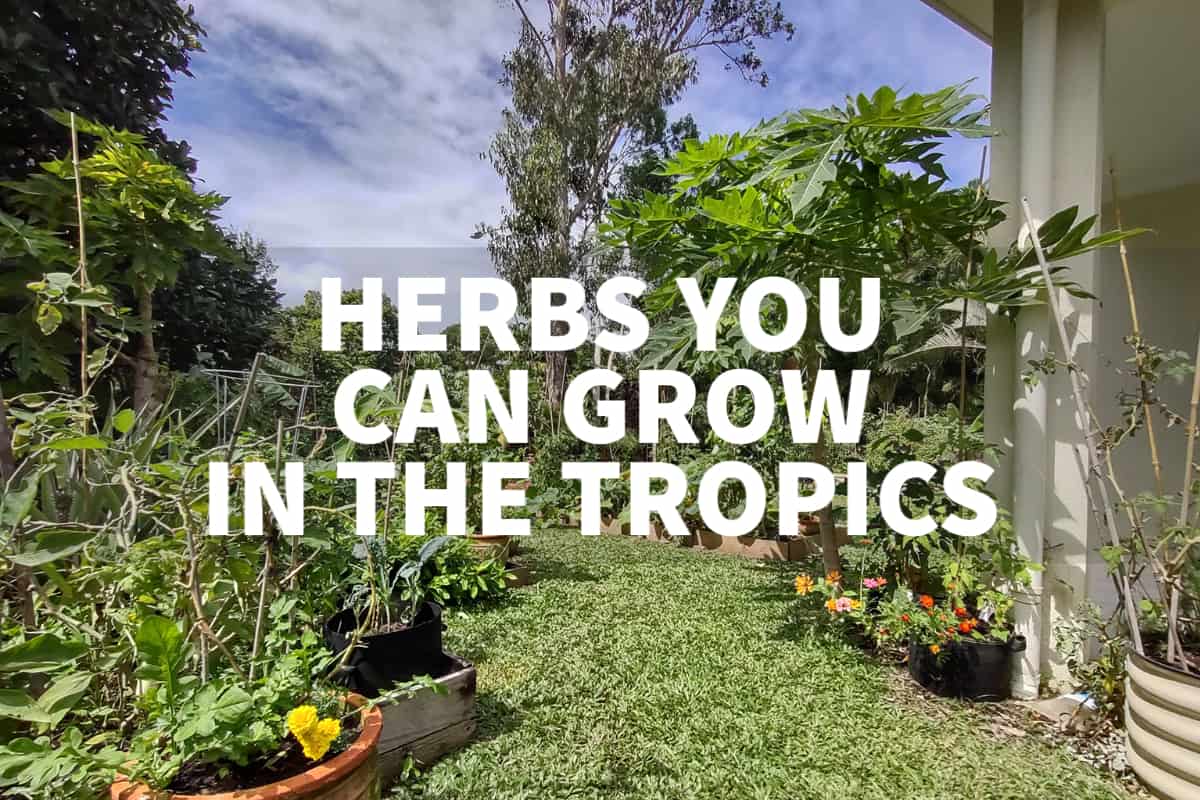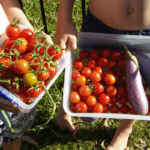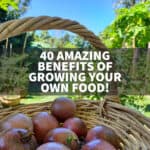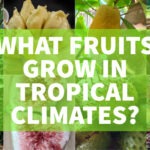This post may contain affiliate links.
You can grow a lot of herbs in the tropics, including those normally associated with cooler or Mediterranean climates. There are some special tropical herbs that do particularly well, but you should be able to grow most herbs without too much difficulty. This post gives you a list of herbs that can be grown in a tropical climate, plus some tips on how to grow them.

I’m growing herbs in tropical Australia, Far North Queensland, so our winter is dry, our summer is the wet or rainy season, which starts around Christmas. We were on very poor soil, a sheet of red clay that I’ve improved over the years. In 2022 we bought a farm property and our soil is now much better.
This meant I’ve had to build beds up and built my own soil, using chop and drop, bought soil, manure, and compost, and my own homemade compost and worm compost.
The herbs we grow in tropical Australia are perfect for the delicious dishes of Thailand and Vietnam, but we can also grow cooler climate herbs with some effort.
In the tropics, mulch is essential to stop the harsh sun baking your soil to death and the rains from washing it away. The best mulch for herbs is what you have. I use hay, sugar cane mulch, or chop and drop. Growing pigeon peas for chop and drop and using anything else from the garden that’s available.
Using chop and drop mulch from your own garden means you can be sure your mulch material is not tainted by herbicides and pesticides.
List of Herbs That Can Be Grown In The Tropics

Probably the easiest herb to grow in a tropical garden, in pots or in soil, is Thai Basil. This bushy herb will give you leaves and flowers the bees love, all year round. It grows as a perennial but I would suggest having more than one plant. These plants do have a tendency to die for no particular reason.
All of the herbs below I have personally had success growing, in containers, in raised beds, and in pots.
- Thai or Asian basil in various flavours.
- Tulsi or holy basil.
- Sweet or European basil, in green and purple forms. Greek columnar basil grows well.
- Dill
- Fennel fronds
- Corriander, Asian spiny and cilantro. Cilantro bolts fast in the sun.
- Rosemary
- Sage
- Mint, various types.
- Chives – garlic or flat-leaf chives. I’m trialling European chives alongside garlic chives right now, both are growing, the garlic chives more prolifically..
- Cuban oregano or Mother of Herbs.
- Oregano, it’s growing well in autumn and winter, but I haven’t grown it through a wet season as yet.
- Tarragon – it grows, but mine has very little flavour.
- Parsley, flat-leaf and curly
- Lemongrass
- Lemon balm
- Kaffir lime leaf
- Vietnamese mint
- Curry leaf, a small invasive tree, its leaves are used fresh in Indian cooking.
Most of the above herbs aren’t truly tropical and will need some protection from intense sun and tropical rain. But all of the above will and can grow in a tropical environment. I know because I grow them!
What Herbs Grow Best in Tropical Climates?

Absolutely 100% my best herbs to grow in our tropical climate are actual tropical herbs that originate in tropical zones such as India and Southeast Asia, not European herbs. Exotic herbs like “mother of herbs”, AKA Cuban or Indian oregano, along with Thai basil is the most prolific herb we grow.
They seem impossible to kill!
Lemon grass is easy to grow too, but becomes a very big, bushy clump which you’ll need to trim and divide.
I also have huge success with mint. This surprised me, but growing mint in the tropics is pretty easy. A few notes on growing mint below.
Growing Mint in the Tropics

We grow mint in our tropical climate year-round. We always have fresh garden mint for mint sauce, dips, tea, or a cheeky cocktail.
Some things you should know about growing mint in a tropical climate include:
- The better you can make your soil, the happier your mint will be and the more prolific your mint leaves.
- The healthier your mint, the less susceptible it is to garden pests. We don’t get slugs or snails in our climate, luckily, but spider mites and grasshoppers can hit our mint. Growing it in pots helps keep bugs at bay.
- Amend your soil at least every year, with compost, worm castings, manure, and minerals. More often, as a top dressing, if possible. If you only do this every few years, your mint should survive, but your harvest and the health of your mint will dwindle.
- Grow mint in pots as it is horribly invasive. It will trail runners over the edges and invade that way too, if you don’t keep an eye on it. Just snip them off and use them for culinary uses or to propagate more pots of mint.
- The roots of mint will choke up your pot. So at least every year-2 years, you’ll need to pull or dig your mint out, divide your clump, and repot the mint plants in good soil.
- Grasshoppers love to eat mint. A visual check and manual squish every day works well for container-grown mint.
- Keep the soil moist. In tropical heat, you may need to water frequently, or shade the pot. Mulch is essential.
- As we don’t have cold winters in the hot, wet, tropics, your mint should grow year-round, pretty much forever.
- Full sun can work for mint if your soil and water retention are good, but I find some afternoon shade makes for easier mint growth.
- Feed your mint if your soil may be exhausted of nutrients. Worm tea or compost tea are good, or a store-bought fertiliser for leafy plants (Nitrogen). Some use dilute urine, but I wouldn’t want to eat the leaves it splashes on! Nitrogen is always the nutrient for leaf growth.
- Cut your mint regularly, or pinch out tips for more abundant, bushy growth.
- Mint reportedly likes a pH of 6-7. So slightly acidic to neutral. Buy a soil pH meter to test this, they’re inexpensive and fun.
- When’s the right time to plant mint in the tropics? The standard advice is to plant in spring, but for us in a hot climate, any time has worked. The mint certainly grows better when its hotter.
Other Flavourings and Aromatics You Can Grow in The Tropics
- ginger
- turmeric
- galangal
- curry leaf (a tree, grows really well!)
- chilli peppers
- Fennel seed
- various spices, for instance pepper, allspice, and cinnamon (of these I only grow pepper, so far!)
Growing Herbs in the Tropical Wet Season
The wet season or rainy season brings torrential monsoon rain and most herbs don’t like sitting in saturated soil. This is why, in the tropics, we often build our beds up to sit above the water level. The plants need to have OK drainage.
Shade cloth or some other form of shade may also be required for mid-day and afternoon sun.
Growing Herbs in the Dry Season
Good soil, plenty of organic matter, frequent waterings, and mulch are the most important factors in getting your herbs to survive the dry season. I tend to water morning and night, twice a day, when it’s very dry.
Never water a plant in full sun. If your herb plant is wilting, it’s natural, it’s a plant’s defence against dehydration. Moving it out of the sun should help. Wait until sundown to water, ideally. You’ll learn to tell the difference between a normal wilt and a fatal one.
Good soil, containing plenty of organic material should hold the water well. If your soil is dry within minutes of watering, you need to add good organic compost or worm castings, anything that will act like a sponge. Vermiculite and peat moss can also be good additions.
Those extra nutrients and microscopic organisms will help your plants too. Plants growing in good soil are bigger, healthier, more lush, and less likely to attract pests.
Some herbs can be decimated by grasshoppers and other pests.
Growing Herbs Indoors
If space is limited outside, yes, it is entirely possible to grow herbs indoors in pots. All you need is sunlight from a window, but even if that isn’t available, daylight full-spectrum, grow lights can be purchased.
I grow a lot of herbs under outside cover. A little protection from full sun and full rain really helps. Under the eves of the house, under trees and on the patio all work well.
Know that morning sun is gentle, afternoon intense sun is much harsher, usually.
Get to know your garden or outside space before planting anything. Observe how the sun moves across the sky in winter and summer.
Will Chickens Eat Herbs?

Chickens will eat some, but not all, garden herbs. Your main problem with free-range chickens in the herb garden will come from them scratching up or trampling young herb plants. You will need to take some chicken-proofing measures.
The stronger, most aromatic herbs are likely to be left alone by your chickens. Our chickens never touch the lemongrass for instance.
A well-established plant should be safe from chickens if it has a good strong root system that they can’t disturb.
Growing Herbs in Aquaponics Systems
Aquaponics systems use water, fish, and plants in harmony to produce well-nourished and watered plants. You can buy a small hydroponics system for use indoors and these are perfect for a small crop of herbs.
Take a look at this counter-top aquaponics set-up, perfect for a few house-friendly herbs indoors.
This is an ever-evolving list of herbs I’ve tried to grow, and grown successfully in the tropical wet and dry seasons. Some I buy as starts from nurseries, some I grow from cuttings or seeds. I have a new herb seed order in right now, I’m looking forward to trying some new varieties of herbs. We also have a full list of food plants we’ve successfully grown in the tropics.









Fantastic, very informative, thanks a lot. I am an animal farmer growing white yorkshire pigs in tamilnadu, india. will plan to grow tropical vegetation, seedlings.
Thaks again
Awesome! Nice to meet you. I know Tamil Nadu, been a few times to India and I always take great inspiration from the gardens we see in India, Sri Lanka, Malaysia, Vietnam, Australia, Thailand etc.